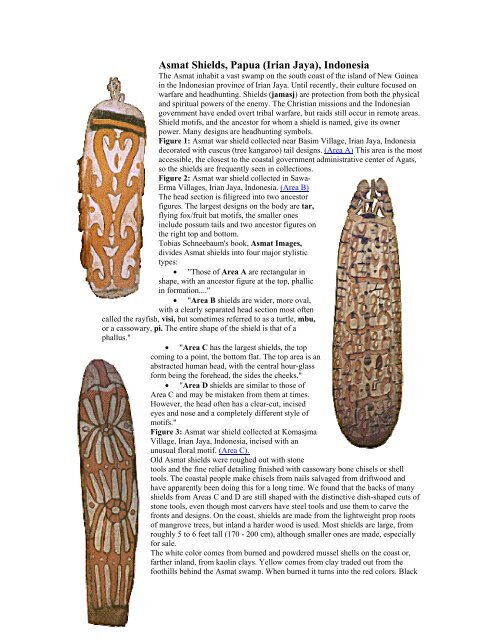Asmat Shields, Papua (Irian Jaya), Indonesia
Asmat Shields, Papua (Irian Jaya), Indonesia
Asmat Shields, Papua (Irian Jaya), Indonesia
You also want an ePaper? Increase the reach of your titles
YUMPU automatically turns print PDFs into web optimized ePapers that Google loves.
<strong>Asmat</strong> <strong>Shields</strong>, <strong>Papua</strong> (<strong>Irian</strong> <strong>Jaya</strong>), <strong>Indonesia</strong><br />
The <strong>Asmat</strong> inhabit a vast swamp on the south coast of the island of New Guinea<br />
in the <strong>Indonesia</strong>n province of <strong>Irian</strong> <strong>Jaya</strong>. Until recently, their culture focused on<br />
warfare and headhunting. <strong>Shields</strong> (jamasj) are protection from both the physical<br />
and spiritual powers of the enemy. The Christian missions and the <strong>Indonesia</strong>n<br />
government have ended overt tribal warfare, but raids still occur in remote areas.<br />
Shield motifs, and the ancestor for whom a shield is named, give its owner<br />
power. Many designs are headhunting symbols.<br />
Figure 1: <strong>Asmat</strong> war shield collected near Basim Village, <strong>Irian</strong> <strong>Jaya</strong>, <strong>Indonesia</strong><br />
decorated with cuscus (tree kangaroo) tail designs. (Area A) This area is the most<br />
accessible, the closest to the coastal government administrative center of Agats,<br />
so the shields are frequently seen in collections.<br />
Figure 2: <strong>Asmat</strong> war shield collected in Sawa-<br />
Erma Villages, <strong>Irian</strong> <strong>Jaya</strong>, <strong>Indonesia</strong>. (Area B)<br />
The head section is filigreed into two ancestor<br />
figures. The largest designs on the body are tar,<br />
flying fox/fruit bat motifs, the smaller ones<br />
include possum tails and two ancestor figures on<br />
the right top and bottom.<br />
Tobias Schneebaum's book, <strong>Asmat</strong> Images,<br />
divides <strong>Asmat</strong> shields into four major stylistic<br />
types:<br />
� "Those of Area A are rectangular in<br />
shape, with an ancestor figure at the top, phallic<br />
in formation...."<br />
� "Area B shields are wider, more oval,<br />
with a clearly separated head section most often<br />
called the rayfish, visi, but sometimes referred to as a turtle, mbu,<br />
or a cassowary, pi. The entire shape of the shield is that of a<br />
phallus."<br />
� "Area C has the largest shields, the top<br />
coming to a point, the bottom flat. The top area is an<br />
abstracted human head, with the central hour-glass<br />
form being the forehead, the sides the cheeks."<br />
� "Area D shields are similar to those of<br />
Area C and may be mistaken from them at times.<br />
However, the head often has a clear-cut, incised<br />
eyes and nose and a completely different style of<br />
motifs."<br />
Figure 3: <strong>Asmat</strong> war shield collected at Komasjma<br />
Village, <strong>Irian</strong> <strong>Jaya</strong>, <strong>Indonesia</strong>, incised with an<br />
unusual floral motif. (Area C).<br />
Old <strong>Asmat</strong> shields were roughed out with stone<br />
tools and the fine relief detailing finished with cassowary bone chisels or shell<br />
tools. The coastal people make chisels from nails salvaged from driftwood and<br />
have apparently been doing this for a long time. We found that the backs of many<br />
shields from Areas C and D are still shaped with the distinctive dish-shaped cuts of<br />
stone tools, even though most carvers have steel tools and use them to carve the<br />
fronts and designs. On the coast, shields are made from the lightweight prop roots<br />
of mangrove trees, but inland a harder wood is used. Most shields are large, from<br />
roughly 5 to 6 feet tall (170 - 200 cm), although smaller ones are made, especially<br />
for sale.<br />
The white color comes from burned and powdered mussel shells on the coast or,<br />
farther inland, from kaolin clays. Yellow comes from clay traded out from the<br />
foothills behind the <strong>Asmat</strong> swamp. When burned it turns into the red colors. Black
comes from crushed charcoal. All colors have magical qualities and represent different aspects of the<br />
<strong>Asmat</strong> world, both seen and unseen. Red is the color of beauty and power. The <strong>Asmat</strong> say that red painted<br />
around the eyes "imitates the color around the eyes of a black king cockatoo when angry and gives a man a<br />
fearsome look."<br />
Figure 4: <strong>Asmat</strong> war shield collected on the Braza River, <strong>Irian</strong> <strong>Jaya</strong>,<br />
<strong>Indonesia</strong>. The design is probably a fish pattern, enam. (Area D)<br />
The <strong>Asmat</strong> <strong>Shields</strong><br />
Traditionally, shields were carved prior to a headhunting reprisal raid, which<br />
was organized to avenge the death of the ancestor for whom the shield was<br />
named. A shield always represents an ancestor. It is named after him and the<br />
ancestor's spirit is believed to be present in the shield and make the owner<br />
fierce, powerful and invincible. <strong>Shields</strong> are considered so powerful that it may<br />
control the owner. <strong>Shields</strong> also provide spiritual help to the owner in hunting<br />
regular prey for food.<br />
A shield is carved out of the lightweight flattened (or plank) buttress root of a<br />
mangrove tree-- the root is planed to half an inch thick, except for a<br />
protrusion left on one side for a handle. The front of the shield is carved in<br />
high relief. They include symbols of wild boar tusks or bones, flying foxes,<br />
the tails of tree kangaroos, whirlpools. Some symbols are believed to be so<br />
powerful that just by seeing these symbols, the enemy will flee in terror or be<br />
immobilized in fear. But such powerful symbols require strict rituals of<br />
appeasement. A special feast, the yamas pokumbu is held to call upon the<br />
ancestor's spirit to enter the war shields.


